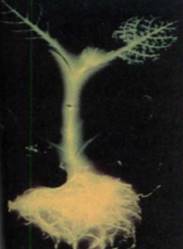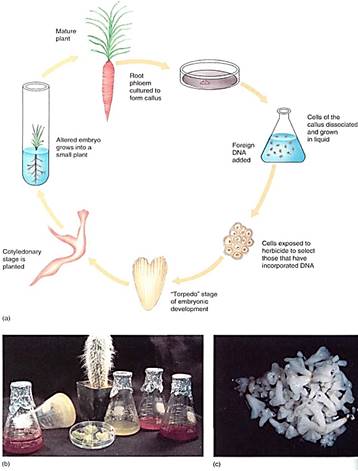
Genetic Engineering of Plants
 المؤلف:
AN INTRODUCTION TO PLANT BIOLOGY-1998
المؤلف:
AN INTRODUCTION TO PLANT BIOLOGY-1998
 المصدر:
JAMES D. MAUSETH
المصدر:
JAMES D. MAUSETH
 الجزء والصفحة:
الجزء والصفحة:
 29-10-2016
29-10-2016
 2491
2491
Genetic Engineering of Plants
Recombinant DNA techniques have made it possible for botanists to identify, isolate, and study the structure and activity of many genes. They also allow botanists to insert genes into plants that do not normally contain those genes. The US Department of Agriculture has approved field trials of many genetically engineered plants. For example, cotton plants have received a gene from the bacterium Bacillus thuringiensis which codes for a protein toxic to caterpillars but not to other insects or mammals (including humans). If the gene protects the plant, it could prevent as much as $100 million in crop losses annually. Botanists have transferred genes from desert petunias into normal petunias, resulting in plants that require 40% less water. If such drought-resistance genes can be transferred to crop plants, the amount of water needed for irrigation will be greatly reduced. Tomatoes have been engineered such that the enzymes which cause them to become mushy are inhibited without inhibiting the other enzymes involved in developing flavor and aroma. The tomatoes can be allowed to ripen fully on the vine but are still firm enough to ship to market.
Obtaining some genes is not very difficult, but at present inserting them into nuclear DNA properly so that they can be transcribed and translated is not easy. A gene may code for an improved, more nutritious storage protein and should be expressed in cotyledons during seed formation. But if the gene inserts into a region of nuclear DNA that codes for root, stem, or wood characteristics, the engineered gene either may not be activated or may become active in the wrong place. Research on the nature of promoter sites and their interaction with chemical messengers is especially intensive. Studies are attempting to locate genes expressed only in particular tissues such as cotyledons, wood, chlorenchyma, or epidermis. Once found, the promoters of these genes will be valuable, because a "cotyledon" promoter could be attached to our foreign gene before insertion. It is assumed that with the correct promoter attached, the gene will respond to the appropriate chemical messenger, regardless of where it inserts into the DNA (Fig. 1).

FIGURE 1:The gene for a luminescent protein from fireflies was inserted into a plant cell in tissue culture; then the cell was induced to grow into a full plant. Apparently, this gene had a promoter that is normally activated in every cell, because all cells are glowing. By attaching different promoters to this gene before the genetic engineering, it is possible to study when and where the promoter is normally active. Biologists hope to find promoters that, when attached to this gene, cause only specific cells or tissues to luminesce; then those promoters can be used whenever we want to affect specifically those types of cell or tissue.
Once a gene and promoter have been prepared, they are attached to an insertion vector, usually the ti plasmid from the bacterium Agrobacterium tumefasciens (Fig. 2). The plasmid has been modified by botanists by adding genes for herbicide resistance. The completed plasmid-promoter-gene is mixed with plant cells in tissue culture; they are allowed to grow and then are treated with the herbicide. Those cells that did not take up the plasmid, and those that took it up but are not expressing it, are killed by the herbicide. The® cells that have taken up the plasmid and are transcribing the gene and translating the mRNA into protein are resistant to the herbicide and survive. They can be cultured further. The surviving cells are induced to form new plants, and in many cases these plants not only carry the gene and express it but pass it on to their progeny when they undergo sexual reproduction.

FIGURE 2: (a) This diagram illustrates the method involved in using recombinant DNA techniques to genetically alter a plant. The method is explained in the text. (b) Several components of a tissue] culture experiment: the original plant (the cactus Cephalocereus senilis), callus culture on agar in foreground, liquid cultures in flasks. The red liquid cultures have been experimentally induced to form pigments. The flask tipped on its side shows that these cells can grow so extensively that they consume all the liquid medium and form a solid mass of cells. (Courtesy of M. Bonness and T. ]. Mabry, University of Texas, Austin) (c) Tissue culture experiments can also produce embryos. If they have been genetically engineered, they grow into altered plants.
 الاكثر قراءة في مواضيع عامة في علم النبات
الاكثر قراءة في مواضيع عامة في علم النبات
 اخر الاخبار
اخر الاخبار
اخبار العتبة العباسية المقدسة


